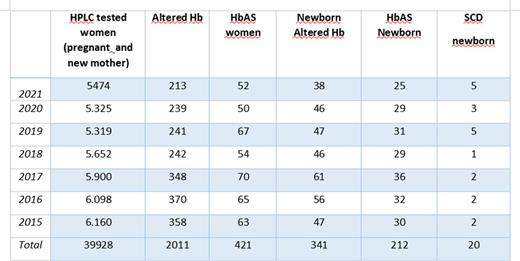Abstract
Introduction
Sickle Cell Disease (SCD) is a global health problem which presents significant challenges to European health care systems. Newborn screening (NBS) for SCD enables early initiation of preventive measures and has contributed to a reduction in childhood mortality from SCD. There are two alternative approaches to NBS. "Targeted screening" takes the ethnic ancestry of every newborn into account. Testing is restricted to babies whose parental family origins are from 'at risk' ethnic groups. In contrast, "universal screening" is offered to the whole newborn population irrespective of family origins. The area of Modena, a province of Emilia Romagna in Northern Italy, with a total population of 700,914 inhabitants, accounts for approximately 92,400 (13.2%) immigrants, mainly from sub-Saharan countries (Ghana, Nigeria, Senegal) in which SCD is endemic. The growing number of new diagnoses in children after the first years of life prompted us to design the first neonatal screening program in the province of Modena from 2011 to 2013. This pilot study allowed us to identify patients with SCD to provide as early as possible appropriate antibiotic prophylaxis, immunizations and comprehensive care. These encouraging results led us to establish a wider screening program, free of charge for the family and supported by the national health system (SSN). We describe the results of 75-year SCD newborn screening from 2015 to 2021.
Methods
The newborn screening program coordinated at the University Hospital of Modena involved all Obstetrics Units of the Province, taking advantage of the organization of the Italian Transfusion Medicine Departments whose mission is to study and prevent the hemolytic disease of the newborn (HDN).
From January 1 2015 to December 31 2021, profile analysis of abnormal hemoglobin (Hb) by high-performance liquid chromatography (HPLC), was offered to all women within 10 weeks of pregnancy according to the Italian Guidelines for Physiological pregnancy. HPLC was also performed at delivery to the new mothers that were not tested previously ( universal screening) and to cord blood of newborns of mothers with altered hemoglobin profile (newborns at risk- target screening ).
Blood samples from mother and newborns were collected daily from all maternity units of the province in EDTA (ethylendiaminetrate-acetic acid anticoagulant) and shipped to the Transfusion Medicine Departament for HDN study and then stored for 7 days at 5°C in accordance with the Italian Legislation.
Results
As shown in Table 1, an abnormal hemoglobin pattern was found in 2011 women and cord blood samples of their newborns at risk were tested within a week of birth .
All 20 SCD ( 14 SS - 6 SC - 1 BS ) affected newborn were identified within 7 days from birth and referred immediately to pediatric hematology department of the University of Modena for early start of prophylaxis protocols and comprehensive care. The birth rate of affected infants was 0.5/1000.
The current follow-up of these patients shows a significant reduction of morbidity and hospital admission compared to those who were not screened .
Conclusion
This is the first example of a universal screening for hemoglobinopaties involving an entire province in Italy. It allowed to start prophylaxis (amoxicillin and vaccination) for newly diagnosed SCD patients within a week after birth which is much earlier than the typical onset of disease symptoms. WHO indicates disease oriented program when the affected birth rate is about 0.5/1000.The benefit of obtaining an early diagnosis of SCD and the limited cost of the procedure support the plan of extending this reliable, simple and cost-effective screening protocol to other Italian regions/geographic areas that could be involved in migration of high-risk population for SCD .
Disclosures
No relevant conflicts of interest to declare.
Author notes
Asterisk with author names denotes non-ASH members.


This feature is available to Subscribers Only
Sign In or Create an Account Close Modal